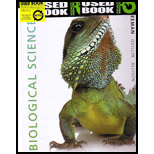
Concept explainers
What are the four nitrogenous bases found in RNA?
a. uracil, guanine, cytosine, thymine (U, G, C, T)
b. adenine, guanine, cytosine, thymine (A, G, C, T)
c. adenine, uracil, guanine, cytosine (A, U, G, C)
d. alanine, threonine, glycine, cysteine (A, T, G, C)
Introduction:
The five nitrogenous bases consisting of nitrogen-containing molecule used in the construction of nucleotides. The nucleotides are the building blocks of the nucleic acids like DNA (deoxyribonucleic acid) and RNA (ribonucleic acid). The DNA and the RNA are the genetic material of an organism.
Answer to Problem 1TYK
Correct answer:
Adenine, cytosine, guanine, and uracil (A, C, G, U) are the four nitrogenous bases which are found in the RNA.
Explanation of Solution
Explanation for the correct answer:
Option (c) is given that A, C, G, and U are the nitrogenous bases found in the RNA. Since a group of five nitrogenous bases is utilized in building the nucleotides. The nitrogenous bases include adenine, guanine, cytosine, thymine, and uracil. The nitrogenous bases can be purines or pyrimidines. The adenine and guanine are six-membered nitrogen-containing rings and they fall under the purines. While thymine, uracil, and cytosine are six-membered nitrogen-containing rings and they fall under pyrimidines. Uracil is found in the RNA and complements adenine instead of thymine. Hence, option (c) is correct.
Explanation for incorrect answers:
Option (a) is given that C, G, T, and U (cytosine, guanine, thymine, and uracil) are the nitrogenous bases found in the RNA. Since, in the case of DNA, adenine forms double bonds with thymine. Adenine complements either thymine or uracil. There is no strand that consists of both thymine and uracil. So, it is an incorrect option.
Option (b) is given that A, C, G, and T (adenine, cytosine, guanine, and thymine) are the nitrogenous bases found in the RNA. Since, A, C, G, and T nitrogenous bases are found in the DNA. In RNA, uracil is present in place of thymine. So, it is an incorrect option.
Option (d) is given that alanine, threonine, glycine, and cysteine are the nitrogenous bases found in the RNA. Since, alanine, cysteine, glycine, and threonine are not found as nitrogenous bases in DNA or RNA. These are amino acids that form codons and each amino acid has multiple codons. So, it is an incorrect option.
Hence, options, (a), (b), and (d) are incorrect.
Thus, it can be concluded that the four nitrogenous bases found in RNA are adenine, cytosine, guanine, and uracil (A, C, G, U).
Want to see more full solutions like this?
Chapter 4 Solutions
Biological Science
- Describe three cranial and postcranial features of Neanderthals skeletons that are likely adaptation to the cold climates of Upper Pleistocene Europe and explain how they are adaptations to a cold climate.arrow_forwardBiology Questionarrow_forward✓ Details Draw a protein that is embedded in a membrane (a transmembrane protein), label the lipid bilayer and the protein. Identify the areas of the lipid bilayer that are hydrophobic and hydrophilic. Draw a membrane with two transporters: a proton pump transporter that uses ATP to generate a proton gradient, and a second transporter that moves glucose by secondary active transport (cartoon-like is ok). It will be important to show protons moving in the correct direction, and that the transporter that is powered by secondary active transport is logically related to the proton pump.arrow_forward
- drawing chemical structure of ATP. please draw in and label whats asked. Thank you.arrow_forwardOutline the negative feedback loop that allows us to maintain a healthy water concentration in our blood. You may use diagram if you wisharrow_forwardGive examples of fat soluble and non-fat soluble hormonesarrow_forward
- Just click view full document and register so you can see the whole document. how do i access this. following from the previous question; https://www.bartleby.com/questions-and-answers/hi-hi-with-this-unit-assessment-psy4406-tp4-report-assessment-material-case-stydu-ms-alecia-moore.-o/5e09906a-5101-4297-a8f7-49449b0bb5a7. on Google this image comes up and i have signed/ payed for the service and unable to access the full document. are you able to copy and past to this response. please see the screenshot from google page. unfortunality its not allowing me attch the image can you please show me the mathmetic calculation/ workout for the reult sectionarrow_forwardIn tabular form, differentiate between reversible and irreversible cell injury.arrow_forwardhelparrow_forward
- Can you please help me answer these questions?arrow_forwardSkryf n kortkuns van die Egyptians pyramids vertel ñ story. Maximum 500 woordearrow_forward1.)What cross will result in half homozygous dominant offspring and half heterozygous offspring? 2.) What cross will result in all heterozygous offspring?arrow_forward
 Human Heredity: Principles and Issues (MindTap Co...BiologyISBN:9781305251052Author:Michael CummingsPublisher:Cengage Learning
Human Heredity: Principles and Issues (MindTap Co...BiologyISBN:9781305251052Author:Michael CummingsPublisher:Cengage Learning Concepts of BiologyBiologyISBN:9781938168116Author:Samantha Fowler, Rebecca Roush, James WisePublisher:OpenStax College
Concepts of BiologyBiologyISBN:9781938168116Author:Samantha Fowler, Rebecca Roush, James WisePublisher:OpenStax College Human Biology (MindTap Course List)BiologyISBN:9781305112100Author:Cecie Starr, Beverly McMillanPublisher:Cengage Learning
Human Biology (MindTap Course List)BiologyISBN:9781305112100Author:Cecie Starr, Beverly McMillanPublisher:Cengage Learning
 Biology: The Dynamic Science (MindTap Course List)BiologyISBN:9781305389892Author:Peter J. Russell, Paul E. Hertz, Beverly McMillanPublisher:Cengage Learning
Biology: The Dynamic Science (MindTap Course List)BiologyISBN:9781305389892Author:Peter J. Russell, Paul E. Hertz, Beverly McMillanPublisher:Cengage Learning Biology Today and Tomorrow without Physiology (Mi...BiologyISBN:9781305117396Author:Cecie Starr, Christine Evers, Lisa StarrPublisher:Cengage Learning
Biology Today and Tomorrow without Physiology (Mi...BiologyISBN:9781305117396Author:Cecie Starr, Christine Evers, Lisa StarrPublisher:Cengage Learning





